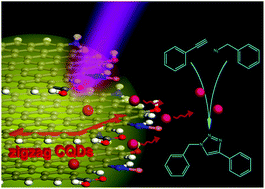Cu(i)-Doped carbon quantum dots with zigzag edge structures for highly efficient catalysis of azide–alkyne cycloadditions†
Abstract
Photoluminescent (PL) carbon quantum dots (CQDs), in which Cu(I) was doped stably owing to their specific zigzag edge structure, were used for catalyzing the Huisgen 1,3-dipolar cycloaddition between azides and alkynes, the prototypical reaction of “click chemistry”. The results showed the great potential of the as-prepared CQDs in catalysis chemistry applications.

- This article is part of the themed collection: 2017 Green Chemistry Hot Articles


 Please wait while we load your content...
Please wait while we load your content...